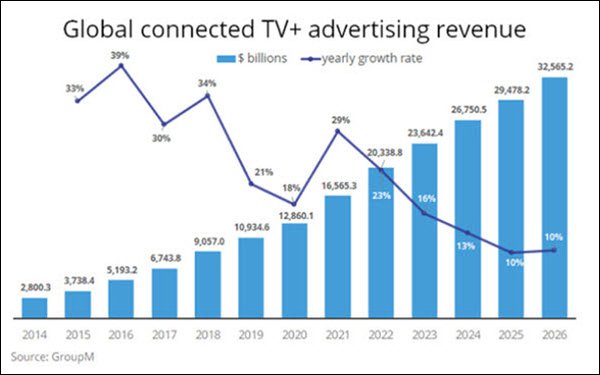Brian Wieser, principal of the consulting firm Madison and Wall, projects that connected television will generate $20 billion in advertising revenue in the United States this year.
The economist forecasts that CTV will increase by 18 percent in 2024, with the same rate of expansion occurring in the first quarter.
CTV is defined by Wieser as digital extensions of professionally produced content and traditional media that are predominantly viewed in the living room, as opposed to on a smartphone or computer. The channel is projected to account for 29% of all television advertising in 2024.
READ MORE: X Could Launch CTV App This Week

However, national television (excluding political advertising) is anticipated to experience further declines, with ad revenues falling 3.5% in the first quarter and 3.2% for the entire year. TV and CTV will continue to face obstacles, according to Wieser, as advertisers reallocate their media expenditures to performance channels and negative sentiment stems from cord-cutting and the decline in national reach for television.
Nonetheless, the Olympics were emphasized in the forecast as a bright point on the television schedule for advertisers seeking the level of reach that television can provide. Wieser stated, “I believe this figure will be modestly supported by the Summer Olympics, which will likely retain much, if not more, of the appeal it has always had with advertisers.”

Moreover, he anticipates that CTV will prosper well in the interim amidst the general decline of television. The economist highlighted Amazon Prime Video, whose parent company will generate “a substantial amount of revenue” from its new ad-supported tier. However, as opposed to attracting new spending into the TV category, Wieser noted that these gains will predominantly accrue at the expense of other proprietors of traditional TV advertising inventory.
A positive economic outlook
In regard to the wider US advertising market, the report projects a total growth of 5.6% (excluding political advertising) in 2024. The outlook for the first quarter is especially optimistic, with an anticipated 8 percent increase in revenue. The projection represents an enhancement over Wieser’s prior prognosis, which anticipated a 5.2 percent annual expansion and a 7 percent growth in the first quarter.
READ MORE: Discrepancies In CTV Advertising Revenue Distribution Endanger Free-To-Air Broadcast TV Channels
The report highlights anticipated improvements in the United States economy, noting that February GDP projections for 2024 increased by approximately one percentage point in comparison to November 2023.

Additionally, Wieser cited the proliferation of online businesses, which allocate greater resources towards advertising. Ecommerce-based retailers, according to him, “are generally four times more intense with advertisements than physical retailers.” For instance, digital game publishers are more reliant on advertisements than traditional game manufacturers, and online travel agencies are more reliant on advertisements than traditional agencies. Therefore, as these ad-heavy competitors gain market share at the expense of physical or conventional businesses, the ad market expands.
Digital benefits
The decline of television in the mix can be attributed to the fact that advertisers tend to prefer commerce media over television advertising due to the online character of those businesses.
“With regard to specific media, I anticipate that the fluctuating budget allocations that have been occurring since 2023 will continue in general,” Wieser stated. “These changes ought to encompass continuous market share increases for digital advertising, moderate market share declines for outdoor advertising, and greater market share declines for audio and television-based media companies as well as publishers of print-based content.”

Hence, it is anticipated that digital advertising will increase its proportion of ad revenues from 64% in 2023 to 76% in 2028. Wieser foresees a “moderate deceleration” in the growth of digital advertising (excluding political) in the near future, with growth of 10.7 percent for the entire year and 14.2 percent in the first quarter of 2024 (compared to 12.9 percent in 2023).
According to Wieser, commerce media is projected to nearly double in scale within digital advertising over the next five years, reaching $82 billion in ad revenues by 2028.
Moreover, social media is anticipated to increase at a rate comparable to that of digital advertising as a whole, by 14.5% in the first quarter and 11.7% by 2024. According to the report, social media and other logged-in environments will generally benefit from the difficulties confronting the open web, such as decreased advertiser interest and decreased consumer utilization caused by AI-based content.
“In pursuit of this objective, open web advertising, encompassing open cost-per-click (CPT), digital out-of-home (OOH), digital audio, and other non-walled garden formats, is anticipated to experience modest expansion in the coming years,” said Wieser. “However, it is acknowledged that increased investments in content—whether propelled by artificial intelligence (AI) or human intervention—could ultimately result in improved content, increased trust, greater usage, and increased advertiser interest.”
Radiant TV, offering to elevate your entertainment game! Movies, TV series, exclusive interviews, music, and more—download now on various devices, including iPhones, Androids, smart TVs, Apple TV, Fire Stick, and more.


